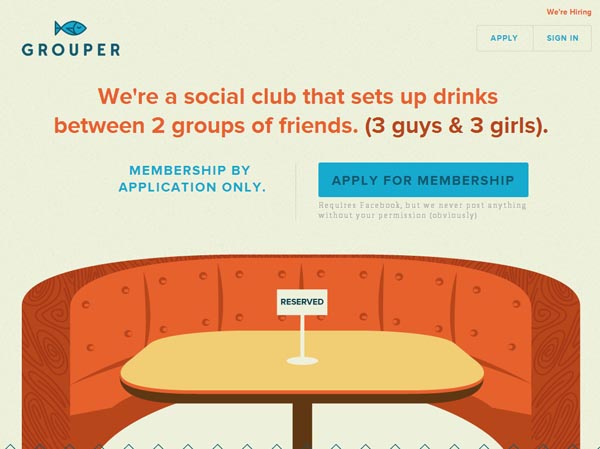The Magic of Providing Less
October 2012I’ve noticed a trend among Internet startups: while some continue to focus on providing an endless amount of choice, many have determined that they can compete by providing fewer, well-thought out choices. My company, Art Sumo, clearly took this approach and it’s been working pretty well for us. Below I offer a few reasons why we decided to offer less, and outline the strategy of curation by looking at a couple of other startups who are succeeding by providing fewer options as well.
Why would fewer be better?
In The Paradox of Choice: Why More Is Less, American psychologist Barry Schwartz reasoned that a certain anxiety sets in when consumers are confronted with too many choices. Rather than feel empowered by the number of choices at their disposal, consumers often feel paralyzed by them as they feel they need to research all the options available in order to make a decision.
Further, in his TED Talk, Schwartz describes a recent experience purchasing a pair of jeans. When Schwartz summoned a sales person for assistance, rather than just being asked his dimensions, the salesperson asked: Would you like bootcut or straight cut, acid wash or clean wash, worker or casual, etc.? Feeling overwhelmed by the experience and not as happy about the jeans he finally bought, Schwartz decided to investigate the issue thoroughly by writing a book. Schwartz concluded that, although in the end he actually purchased an objectively better pair of jeans than he could have purchased in the 80s, when there were fewer options, he wasn’t as happy with his decision. This is his TED talk:
While we assume that more choices allows us to customize exactly what we want, in cases where we don’t really know what we want, sometimes choice can be more of a burden than a help.
Art Sumo
When I was starting out with Art Sumo, I had a vested interest in providing fewer options and trying to get away with it. More options meant more inventory, more artists to deal with, and a much larger risk with an idea that was still unproven.
 </a>
</a>
So to start out, with Groupon on the rise, we decided to focus on offering less options but providing them in a curated manner. Our strategy would be to send out a single painting a day to our customer base and make it available for sale. My hope was that people would stay subscribed to keep looking at interesting art on a daily basis and, if they ever loved a painting, they would feel an urgency to buy it.
After launching, many gallery owners told us that the experience matches more closely with how people actually look at art in a gallery. Most art aficionados generally examine paintings one by one before falling in love with any single one; if they do decide they like one, they might ask themselves if it matches their interior. It is pretty rare to walk into a gallery and say something like “I need a painting, between 20-30 inches wide with a white exterior, inspired by Van Gogh,” like some art sites facilitate.
Grouper
Filling an online marketplace is tough in any niche. It’s particularly challenging in online dating where there are many more men than women looking for dates, everyone wants to date the same people and people only want to date until they end up in a relationship.

Observing these challenges, Grouper decided to curate the dating experience. Rather than providing a searchable, online database, like typical online dating sites, Grouper uses the information contained on your Facebook profile to pair you up on a blind date with one person of the opposite sex that best matches you. To ease the pressure, increase the odds of a good match, and make it feel less like blind dating, they ask both the guy and the girl to bring two friends each to the bar.
I love the idea since not only is it a more natural way and fun way to date, it’s also a great business strategy! By curating the experience and pairing up just two people they need remarkably fewer people in their database to be of service. In fact, Grouper just needs two people in a single locale to provide their users with value.
Jack Threads
The story of Jason Ross and Jack Threads is pretty awesome. Jason thought that there should be a market for designer men’s clothing at a discount. To test interest without investing too much in inventory, Jason created a site which provided a deal a day service of fashionable item a day. Users could purchase only the item shown on the site each day. Since the deals were so good, users signed up in the thousands.

With the market proven, Jason hustled conferences, got exposure on many blogs, and managed to build an email list of 350,000 members in a single year! With many more members, Jason changed the site to a flash sale, similar to Gilt, so as to provide an impetus to buy urgently, but providing more options to his large list of members.
How To Scale
While curation is great for all the reasons stated above, it does have a big glaring problem: Scale! While people may enjoy fewer options, this means that there are fewer opportunities to sell. And fewer opportunities to sell means it is harder to make money.
Therefore, while Jack Threads, Woot, and Groupon all started out with the model of providing a single item a day and fewer choices, once their lists become large enough, they started expanding and providing more options to customers. While this might seem like it is counter-productive to the whole curated experience, all these sites have done it in an intelligent way which I don’t believe has harmed their curated offering. Groupon, for example, still provides one custom local deal in your inbox each day. However, right next to their promoted deal of the day, they offer other options for you as well. This has allowed Groupon to scale all the way to an IPO.
Do you agree with the strategy of providing fewer options early on? Please share your thoughts in the comments or on hackernews.